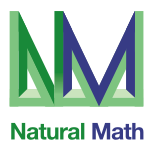Multiplication Explorers LIVE March 28-20, bloggers at play, book bundle sale: Newsletter March 19, 2016
Subscribe and read archives
Pinterest | Twitter | Facebook
Multiplication Explorers LIVE March 28-30
We are running a live, highly interactive online workshop for 25 parents, math circle leaders, and teachers, with children ages 2 and up, on March 28-30, with live meetings at noon-1:30 PM EST.
Multiplication Explorers LIVE will help you grow your math intuition, share the joy and beauty of mathematical activities related to multiplication, and develop your confidence in leading activities with your family, math circle, or class.
Do you remember how you felt studying the multiplication tables? For so many people we meet, the dislike and fear of math can be traced all the way back to their struggles to understand (and not just memorize) multiplication. Can we change this pattern so our children feel curiosity, joy, and affinity – rather than fear, anxiety, and alienation? Can multiplication be more about smart play, rich mathematical thinking, and usefulness everywhere in life?
Multiplication Explorers materials explore holistic approaches to learning multiplication. We invite you to boldly go beyond the familiar representations of multiplication such as skip counting and repeated addition, to work and play with many meaningful, beautiful, and fun models. This live workshop will get you started with adventures across the universe of multiplication.
Math is what you make of it: play along with these bloggers and their children
Natural Math is all about going on your own adventures, and using ideas in your own ways. Want your story featured here? Contact us!
Sara and her four girls at Happiness Is Here blog play with mirror book activities from Moebius Noodles, and share many gorgeous photos as they explore symmetry, angles, multiplication, and spatial transformations.
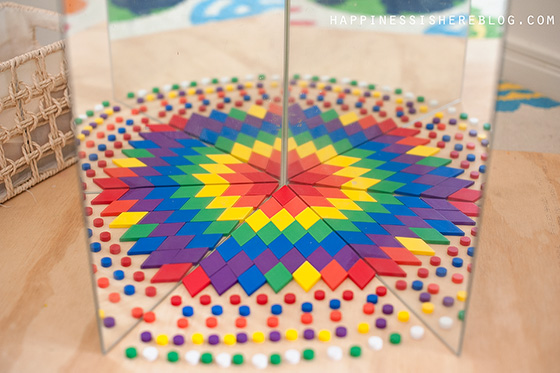
Sara writes: I love this rainbow flower by Miss 7. An accidental discovery. When she was going to pack up the rainbow flower she moved the mirrors back and noticed she’d created something different. She then played around with the angles for a while creating different variations with the same parts. They now do this after every creation.
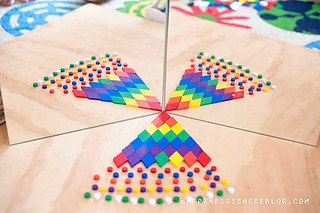
Even Miss 2 had a go. She enjoyed gently throwing some pieces and watching all the reflected pieces fall in synchronicity.
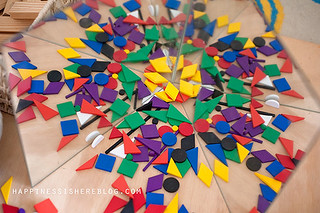
Jen Mendez at PERMIE KIDs posted a 25-minute podcast story inspired by activities from the book Socks Are Like Pants, Cats Are Like Dogs. She expands on an early algebra activity called This Is Like That, where you seek variables that link different things, like cats and dogs. Jen connects the activity to a philosophical idea she’s been exploring.
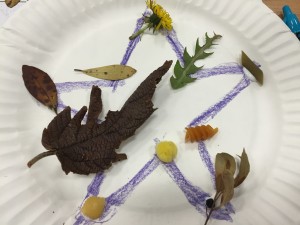
Jen writes: All in Relation can feel like a big, abstract idea, especially when talking about it philosophically, so how can we help children start to look at themselves, others and the world through this lens? One of the fundamental premises of All in Relation as an ethic is understanding how seeming unrelated things have a relationship. This book [Socks Are Like Pants] inspires families and groups to play, solve, talk, and make math-together. The book is filled with a diverse collection of math games, puzzles, and activities exploring the mathematics of choosing, identifying and sorting. Ready for some hands-on, minds-on learning activities that will inspire deeper connections? Play math today and let inspiration grow!
Book bundle sale is now for ebooks too
The latest Natural Math book for parents, math circle leaders, and teachers is called Bright, Brave, Open Minds: Engaging Young Children in Math Inquiry. To celebrate, we offer a limited-time sale on our book bundles. Several of you asked if we have an ebook bundle in addition to paperbacks, so here it is! You save $29 on the paperback bundle and $16 on ebook bundle.
Dr. Maria Droujkova and the Natural Math crew
![]()
Questions? Email reach.out@naturalmath.com or ask in comments to this page.
Posted in Make & Grow, Newsletter
Making Rice & Understanding Circumference
Rice and circumference go together? Why, yes, they do!
Yesterday, I was playing with the Going in Circles spark from the Inspired by Calculus class with my online class and my children. We did this activity.
We had so much fun verifying that the difference in the lengths of string was really the same no matter how big or small your original circle seemed to be. One student even did the activity in reverse. He noticed that drawing a new circle with a radius that was 1/2″ longer added 3″ to the string. When he did a circle with a radius that was 1″ longer, it added 6″ to the amount of string needed to go around the new circle (as compared to the original circle). So he guessed if he had a 9″ difference that the radius would increase by 1.5″ compared to the original circle. Then he tested his hypothesis! I was so excited by his thinking process! It was a bit challenging to use string and get accurate measurements.
Another neat question that arose, when we showed that the difference in circumference is always the same amount no matter the original circle size, was WHY!? Two of my students were really annoyed and wanted to know “Why! Mrs. Nash. How is that possible!” After racking my brain for a moment we settled on the analogy of making rice. It’s a proportion, and that’s where Pi really started to click (even for me!) Just like making rice is always 1 part rice : 2 parts water; circles are always increasing by 2π.

photo by Deborah Austin. CC-BY-2.0
So if I need 9 cups of rice I measure 3:6; if I need 24 cups of rice I measure 8:16; but no matter how BIG the amount of rice I need, the proportion will be the same. That’s when they got it—that’s when I got it! No matter how big my starting circle (even if it’s the earth), the proportion I add is connected to 2π . It’s a ratio!
Here’s a bit of my own math I did after the class.
- Original Circle: Radius of 10, circumference abt 60
- 1/2″ larger: Radius of 10.5, circumference abt 63
- 1″ larger: Radius of 11, circumference abt 66
- 1.5″ larger: Radius 11.5, circumference abt 69
Ta da! Can you see the 3 (or 3.14….) ratio! So much fun for my brain to see it!
If you’d like to try the sparks too, watch for our next Inspired by Calculus class.
Posted in A Math Circle Journey
Where’s math in this play? Open Minds book is out, and our new book bundle. Newsletter March 7, 2016
Subscribe and read archives
Pinterest | Twitter | Facebook
Where is mathematics? Playing with blocks online, March 10
Sian Zelbo, a co-author and illustrator of the popular math circle and family book Camp Logic, is working on her next book, Playing With Blocks. Parents and teachers often tell us, “Yes, we see how your activities are beautiful and playful, and we want that for our children’s math. But we can’t find the math in our play. Help!” Sian’s book helps you to see deep mathematics in playful activities. And now, you have a chance to work with Sian Zelbo and Sally Bishop live, during a workshop we offer.
The activity you will explore in the online workshop is a joyful and elegant example of mathematics that starts easy, and then takes you far. The areas of math you will touch come from the subjects of geometry, number theory, and combinatorics.

You will help your children grow their math eyes, and notice unexpected links between concepts such as angle and area, minimum/maximum and perimeter, combinations that form a sum and types of triangles (equilateral, scalene, and so on). You will make bridges to other rich math activities, such as pentaminoes and tangrams.

As we talk, you will pick up good math terms for this exploration, and good search phrases for when you want to investigate these topics more. You will also collect questions you can ask about any problem, to learn deeper, more joyful math. For example:
- What makes Thing One and Thing Two similar or different? (For example, a triangle and a square.)
- What is the largest thing you can make? How do you measure your things? (For example, using a grid to measure areas.)
- What if you change your numbers around? What other things you can change? (For example, 10 toothpicks instead of 12.)
Check out a sample activity you can try, from our online workshop centered on the new book’s ideas. It runs on March 10 and 11, and is for parents and teachers with children ages 5-12.
A new Natural Math book is out!
The latest Natural Math book for parents, math circle leaders, and teachers is called Bright, Brave, Open Minds: Engaging Young Children in Math Inquiry. Go to the book’s page to try out several activities with your children, and get a taste of the inquiry-based approach to playful, deep mathematics.
In the introduction, the author Julia Brodsky writes:
I will share with you what I have learned as I tinkered with teaching problem solving to curious young children, ages six to eight. The purpose of this book is to invite you to experiment with your own children or students, without any preconceived notions of how the outcome will look. Instead, allow your personal taste and the children’s feedback to guide you.
As all our books, Open Minds is available in paperback as well as electronic formats and name-your-price PDF. To celebrate, we offer a limited-time sale on our book bundle. Check it out!
Dr. Maria Droujkova and the Natural Math crew
![]()
Questions? Email reach.out@naturalmath.com or ask in comments to this page.
Posted in Make & Grow, Newsletter
Playing With Blocks: Newsletter March 2, 2016
Subscribe and read archives
Pinterest | Twitter | Facebook
Playing With Blocks ideas, and a workshop on March 10
Sian Zelbo, a co-author and illustrator of the popular math circle and family book Camp Logic, is working on her next book, Playing With Blocks. You can grab this Math Spark and play-test an activity from the book with your children: easy, addictive, smart toothpick puzzles!
Sally Bishop, an enthusiastic Natural Math leader, has joined Sian to offer an online workshop centered on the new book’s ideas. It runs on March 10 and 11, and is for parents and teachers with children ages 5-12.
What do you get if you join Playing With Blocks workshop?
- A highly interactive experience where you make models, talk, and collaborate with 24 other parents and teachers. We keep our groups small.
- Leading your children or students on playful math adventures.
- The first meeting in a math circle format (you as a student!) to see how to run these activities, and to get inspired.
- A day to try activities with children and friends
- The second meeting to answer your questions, overview other activities, and prepare to do more with children.
- Insight on how to adapt puzzles and problems to facilitate endless math exploration.
- Make an impact on another Natural Math book by sharing your ideas directly with the author
- (The crowdfunding option) Your name as one of crowdfunders in Sian Zelbo’s new book, Playing With Blocks, and the paperback and ebook copies (~Fall 2016)
- Most importantly, you’ll get the confidence in your own ability to do math differently in your family or group!
Dr. Maria Droujkova and the Natural Math crew
![]()
Questions? Email reach.out@naturalmath.com or ask in comments to this page.
Posted in Make & Grow, Newsletter

